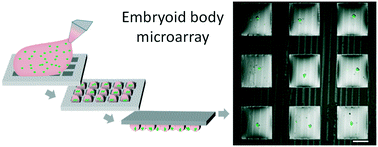Droplet microarray: miniaturized platform for rapid formation and high-throughput screening of embryoid bodies†
Abstract
Stem cells are influenced by various factors present in their in vivo microenvironment, such as interactions with neighboring cells, the extracellular matrix or soluble molecules. This demonstrates the high complexity of the in vivo microenvironment. Hence, many advances have been made in developing 3D screening models mimicking this complexity and the in vivo-like state in order to ensure more biomedically relevant investigations in drug discovery. In the field of stem cell research embryoid bodies are often used as relevant 3D systems. Embryoid bodies are embryonic stem cell aggregates that recapitulate the early embryonic development and that can differentiate into derivatives of the three germ layers. Embryoid bodies enable the investigation of processes underlying embryonic development, tissue generation and identification of drugs with developmental toxicity. The ability to perform high-throughput screenings using embryoid bodies could be extremely important to accelerate the progress in the field of stem cell research and embryonic development. To date, there are no simple methods to create high-density microarrays of embryoid bodies that further enable their high-throughput screening important for biomedical research. Here we demonstrate a new method that enables formation and high-throughput screening of embryoid bodies in arrays of defined, separated microdroplets. Using the superhydrophobic–hydrophilic micropattern of the droplet microarray, we demonstrate rapid and facile one-step formation of a dense array of multiple droplets containing homogeneous, single embryoid bodies. Thorough characterization of the influence of the initial cell number on embryoid body size, roundness and distribution was performed. We applied the embryoid body microarray to screen 774 FDA-approved compounds, identifying compounds with developmental toxicity such as mycophenolate mofetil or embryonic lethality such as eptifibatide. This work demonstrates the potential of the droplet microarray for the rapid formation of high-density microarrays of single embryoid bodies and their high-throughput drug screenings.



 Please wait while we load your content...
Please wait while we load your content...